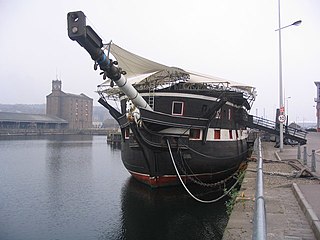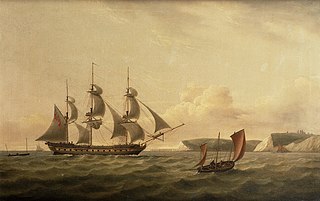Related Research Articles

In 1603 all English warships with a compliment of fewer than 160 men were known as 'small ships'. In 1625/26 to establish pay rates for officers a six tier naval ship rating system was introduced. These small ships were divided into three tiers, Fourth, Fifth and Sixth rates. Up to the end of the 17th century the number of guns and the compliment size was adjusted until the rating system was actually clarified. A 'Fourth Rate' was nominally a ship of over thirty guns with a complement of 140 men.

In the 18th century and most of the 19th, a sloop-of-war in the Royal Navy was a warship with a single gun deck that carried up to eighteen guns. The rating system covered all vessels with 20 guns and above; thus, the term sloop-of-war encompassed all the unrated combat vessels, including the very small gun-brigs and cutters. In technical terms, even the more specialised bomb vessels and fireships were classed as sloops-of-war, and in practice these were employed in the sloop role when not carrying out their specialised functions.

Hartlepool is a seaside and port town in County Durham, England. It is the largest settlement and administrative centre of the Borough of Hartlepool. With an estimated population of 90,123, it is the second-largest settlement in County Durham.

The Gunboat War was a naval conflict between Denmark–Norway and the British during the Napoleonic Wars. The war's name is derived from the Danish tactic of employing small gunboats against the materially superior Royal Navy. In Scandinavia it is seen as the later stage of the English Wars, whose commencement is accounted as the First Battle of Copenhagen in 1801.

HMS Cornwall was a 74-gun third-rate Vengeur-class ship of the line built for the Royal Navy in the 1810s. She spent most of her service in reserve and was converted into a reformatory and a school ship in her later years. The ship was broken up in 1875.

The Maritime Museum of San Diego, established in 1948, preserves one of the largest collections of historic sea vessels in the United States. Located on the San Diego Bay, the centerpiece of the museum's collection is the Star of India, an 1863 iron bark. The museum maintains the MacMullen Library and Research Archives aboard the 1898 ferryboat Berkeley. The museum also publishes the quarterly peer-reviewed journal Mains'l Haul: A Journal of Pacific Maritime History.

HMS Trincomalee is a Royal Navy Leda-class sailing frigate built shortly after the end of the Napoleonic Wars. She is now restored as a museum ship afloat in the National Museum of the Royal Navy, Hartlepool, England.

HMSUnicorn is a surviving sailing frigate of the successful Leda class, although the original design had been modified by the time that the Unicorn was built, to incorporate a circular stern and "small-timber" system of construction. Listed as part of the National Historic Fleet, Unicorn is now a museum ship in Dundee, Scotland, United Kingdom. She is the oldest ship in Scotland, one of the six oldest ships in the world, and one of the last intact warships from the age of sail.

The capture of USS Chesapeake, also known as the Battle of Boston Harbor, was fought on 1 June 1813, between the Royal Navy frigate HMS Shannon and the United States Navy frigate USS Chesapeake, as part of the War of 1812 between the United States and the United Kingdom. The Chesapeake was captured in a brief but intense action in which 71 men were killed. This was the only frigate action of the war in which there was no preponderance of force on either side.

John Cooke was an experienced and highly regarded officer of the Royal Navy during the American War of Independence, the French Revolutionary Wars and the first years of the Napoleonic Wars. Cooke is best known for his death in hand-to-hand combat with French forces during the Battle of Trafalgar in 1805. During the action, his ship HMS Bellerophon was badly damaged and boarded by sailors and marines from the French ship of the line Aigle. Cooke was killed in the ensuing melee, but his crew successfully drove off their opponents and ultimately forced the surrender of Aigle.

The National Museum of the Royal Navy (NMRN) is a maritime exposition and visitor attraction in Hartlepool, County Durham, Northern England. The concept of the attraction is the thematic re-creation of an 18th-century seaport, in the time of Lord Nelson, Napoleon and the Battle of Trafalgar. HMS Trincomalee, a Royal Navy frigate and Britain's oldest warship afloat is at the centre of the quay. She was built in Bombay, India in 1817. The 190th anniversary of the ship's official launch was on Friday 12 October 2007.

The National Museum of the Royal Navy was created in early 2009 to act as a single non-departmental public body for the museums of the Royal Navy. With venues across the United Kingdom, the museums detail the history of the Royal Navy operating on and under the sea, on land and in the air.

HMS Gloucester was a 74-gun, third rate Vengeur-class ship of the line built for the Royal Navy in the 1810s. She played a minor role in the Napoleonic Wars and was cut down into a 50-gun fourth rate frigate in 1831–32. The ship was converted into a receiving ship and broken up in 1884.

The Cruizer class was an 18-gun class of brig-sloops of the Royal Navy. Brig-sloops were the same as ship-sloops except for their rigging. A ship-sloop was rigged with three masts whereas a brig-sloop was rigged as a brig with only a fore mast and a main mast.

HMS Vengeance was originally the 48-gun French Navy frigate Vengeance and lead ship of her class. She engaged USS Constellation during the Quasi-War, in an inconclusive engagement that left both ships heavily damaged. During the French Revolutionary Wars, HMS Seine hunted Vengeance down and captured her after a sharp action. She was recommissioned in the Royal Navy as the 38-gun fifth rate HMS Vengeance, but the British apparently never returned her to seagoing service. Accounts are divided as to her eventual fate. She may have been broken up in 1803 after grounding in 1801, or continued as a prison ship until 1814.

HMS Amazon was a 38-gun fifth-rate Amazon-class frigate of the Royal Navy. She served during the French Revolutionary and Napoleonic Wars under several notable naval commanders and played a key role in the Battle of Copenhagen under Edward Riou, who commanded the frigate squadron during the attack. After Riou was killed during the battle, command briefly devolved to John Quilliam. Quilliam made a significant impression on Horatio Nelson, who appointed Quilliam to serve on the flagship HMS Victory. Amazon passed to William Parker, who continued the association with Nelson with service in the Mediterranean and participation in the chase to the West Indies during the Trafalgar Campaign. Amazon went on to join Sir John Borlase Warren's squadron in the Atlantic and took part in the defeat of Charles-Alexandre Léon Durand Linois's forces at the action of 13 March 1806. During the battle, she hunted down and captured the 40-gun frigate Belle Poule.
HMS Alban was one of twelve Adonis-class schooners of the Royal Navy and was launched in 1806. She served during the Napoleonic Wars. During the Gunboat War she took part in two engagements with Danish gunboats, during the second of which the Danes captured her. The British recaptured her seven months later, but she was wrecked in 1812.
The action of 4 September 1782 was a small naval engagement fought off the Île de Batz between a French naval frigate, Hébé, and a Royal Naval frigate, HMS Rainbow. This battle was notable as the first proper use of a carronade, and so effective was this weapon that the French commander promptly surrendered just after the first broadside.

The action of 10 August 1780 was a minor naval engagement that took place off Brest during the American Revolutionary War between a Royal Navy frigate and a French Navy frigate. This was the first engagement thought to involve the use of the carronade.

USRCSurveyor was a ship of the United States Revenue Marine captured by the United Kingdom during the War of 1812. Despite the vessel's loss, the "gallant and desperate" defense of her crew against a superior force of the Royal Navy and the Corps of Royal Marines is commemorated by the United States Coast Guard. Along with the Royal Navy frigate which bested her in battle, HMS Narcissus, Surveyor is among six legendary ships memorialized in the lyrics of the Coast Guard march "Semper Paratus".
References
- ↑ "Gold Beach 60 Years On - Historical Maritime Society" . Retrieved 13 May 2016.
- ↑ administrator. "Hartlepool Historic Quay". This is Hartlepool. Retrieved 13 May 2016.
- ↑ "Intute". Jisc. Retrieved 13 May 2016.
- ↑ "Programmes - Most Popular - All 4". Channel 4. Retrieved 13 May 2016.
- ↑ "HMS Trincomalee Filming". Archived from the original on 21 July 2007. Retrieved 13 April 2009.
{{cite web}}: CS1 maint: unfit URL (link) - ↑ Isemonger, Paul Lewis. (1998). Nelson's War. In: Wellington's War. Sutton Publishing Ltd. Stroud, Gloucestershire, UK: . pp 86-111.
- ↑ Napoleonic Wars
- ↑ "Carronade". Archived from the original on 2 January 2008. Retrieved 6 March 2008.
- ↑ "Skirmish The Living History Magazine" . Retrieved 13 May 2016.
- ↑ HMS(2009). "It's a big B*!£@r, isn't it?" Skirmish - Living History Magazine. No.68 (1), pp 34-36.
- ↑ "Historical Maritime Society at Gloucester Tall Ships Festival 2009". Flickr - Photo Sharing!. 31 May 2009. Retrieved 13 May 2016.
- ↑ "GLOUCESTER May 2009. (302)". 31 May 2009.
- ↑ "HMS in the SECOND WORLD WAR - HMS". sites.google.com. Archived from the original on 15 April 2016.
- ↑ "Dscf2683". September 2012.